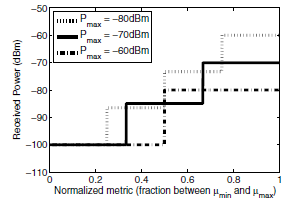TR2009-024
Fast Multiple Access Selection Through Variable Power Transmissions
-
- , "Fast Multiple Access Selection through Variable Power Transmissions", IEEE Transactions on Wireless Communications, Vol. 8, No. 4, pp. 1962-1973, April 2009.BibTeX TR2009-024 PDF
- @article{Yim2009apr,
- author = {Yim, R. and Mehta, N.B. and Molisch, A.F.},
- title = {{Fast Multiple Access Selection through Variable Power Transmissions}},
- journal = {IEEE Transactions on Wireless Communications},
- year = 2009,
- volume = 8,
- number = 4,
- pages = {1962--1973},
- month = apr,
- issn = {1536-1276},
- url = {https://www.merl.com/publications/TR2009-024}
- }
- , "Fast Multiple Access Selection through Variable Power Transmissions", IEEE Transactions on Wireless Communications, Vol. 8, No. 4, pp. 1962-1973, April 2009.
-
Research Area:

Abstract:
Many wireless applications demand a fast mechanism to detect the packet from a node with the highest priority ("best node") only, while packets from nodes with lower priority are irrelevant. In this paper, we introduce an extremely fast contention-based multiple access algorithm that selects the best node and requires only local information of the priorities of the nodes. The algorithm, which we call Variable Power Multiple Access Selection (VP-MAS), uses the local channel state information from the accessing nodes to the receiver, and maps the priorities onto the receive power. It is based on a key result that shows that mapping onto a set of discrete receive power levels is optimal, when the power levels are chosen to exploit packet capture that inherently occurs in a wireless physical layer. The VP-MAS algorithm adjusts the expected number of users that contend in each step and their respective transmission powers, depending on whether previous transmission attempts resulted in capture, idle channel, or collision. We also show how reliable information regarding the total received power at the receiver can be used to improve the algorithm by enhancing the feedback mechanism. The algorithm detects the packet from the best node in 1.5 to 2.1 slots, which is considerably lower than the 2.43 slot average achieved by the best algorithm known to date.
Related News & Events
-
NEWS IEEE Transactions on Wireless Communications: publication by MERL researchers and others Date: April 1, 2009
Where: IEEE Transactions on Wireless Communications
Research Area: CommunicationsBrief- The article "Fast Multiple Access Selection through Variable Power Transmissions" by Yim, R., Mehta, N.B. and Molisch, A.F. was published in IEEE Transactions on Wireless Communications.